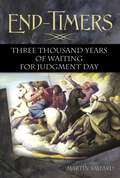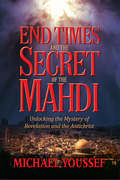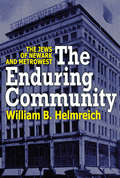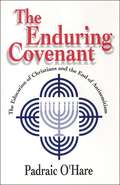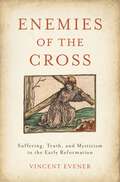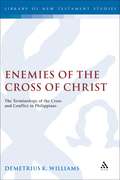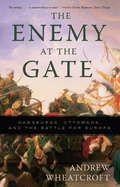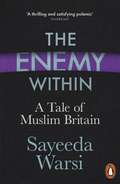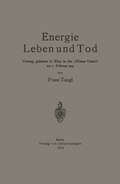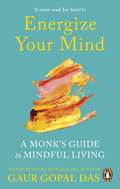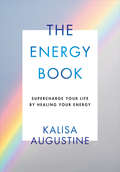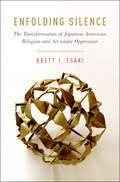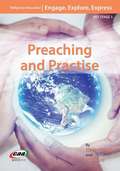- Table View
- List View
The End That Does: Art, Science and Millennial Accomplishment (Millennialism and Society #3)
by Cathy Gutierrez Hillel SchwartzMillennial movements have had a significant impact on history and lie behind many artistic and scientific views of the world. 'The End that Does' tracks the interplay of the arts, sciences, and millennial imagination across 3000 years. The volume presents essays ranging across the study of ancient ritualistic sacrifice, utopian technology and the American millennial dream, science fiction, and the apocalypse of the tabloids. The End that Does will be invaluable to any student or scholar interested in the history of millennialism.
The End That Does: Art, Science and Millennial Accomplishment (Millennialism and Society)
by Cathy Gutierrez Hillel SchwartzMillennial movements have had a significant impact on history and lie behind many artistic and scientific views of the world. 'The End that Does' tracks the interplay of the arts, sciences, and millennial imagination across 3000 years. The volume presents essays ranging across the study of ancient ritualistic sacrifice, utopian technology and the American millennial dream, science fiction, and the apocalypse of the tabloids. The End that Does will be invaluable to any student or scholar interested in the history of millennialism.
End-Timers: Three Thousand Years of Waiting for Judgment Day
by Martin BallardThis fascinating history surveys apocalyptic religion through time, setting it within a political and social context.End-Timers: Three Thousand Years of Waiting for Judgment Day examines the high and low points of millennial expectation across the centuries. It shows how and why such beliefs first developed in antiquity, and it explores how end-timers influenced events as varied as the persecutions of Hellenistic ruler Antiochus Epiphanes and Roman Emperor Nero, the Crusades, the settlement of North America, and the 20th-century debacles at Jonestown and Waco.Suggesting that anyone who wishes to understand the Middle East today needs to penetrate the background of modern fundamentalism within the three Semitic religions, the author illuminates the part played by Christian Zionists in promoting the return of the Jews to the "promised land" and the resulting formation of the state of Israel, as well as subsequent fundamentalist reactions within both Judaism and Islam. He also follows the birth of the "Christian Right" in 19th-century Britain and its development and growing influence in the United States. Finally, the book examines how religious end-timers confront the four horsemen of the 21st-century apocalypse: world population increase, depletion of natural resources, advanced weaponry, and global warming.
End-Timers: Three Thousand Years of Waiting for Judgment Day
by Martin BallardThis fascinating history surveys apocalyptic religion through time, setting it within a political and social context.End-Timers: Three Thousand Years of Waiting for Judgment Day examines the high and low points of millennial expectation across the centuries. It shows how and why such beliefs first developed in antiquity, and it explores how end-timers influenced events as varied as the persecutions of Hellenistic ruler Antiochus Epiphanes and Roman Emperor Nero, the Crusades, the settlement of North America, and the 20th-century debacles at Jonestown and Waco.Suggesting that anyone who wishes to understand the Middle East today needs to penetrate the background of modern fundamentalism within the three Semitic religions, the author illuminates the part played by Christian Zionists in promoting the return of the Jews to the "promised land" and the resulting formation of the state of Israel, as well as subsequent fundamentalist reactions within both Judaism and Islam. He also follows the birth of the "Christian Right" in 19th-century Britain and its development and growing influence in the United States. Finally, the book examines how religious end-timers confront the four horsemen of the 21st-century apocalypse: world population increase, depletion of natural resources, advanced weaponry, and global warming.
End Times and the Secret of the Mahdi: Unlocking the Mystery of Revelation and the Antichrist
by Michael YoussefThe emergence of Radical Islamists should be no surprise to students of Scripture. America is only now understanding their intense passion to rule, not only the Middle East, but the western world as well. Youssef points to passages that show us how biblical prophecy speaks to the awful things to come. Beware of the secret of the Mahdi!
The Ending of the Canon: A Canonical and Intertextual Reading of Revelation 21-22 (The Library of New Testament Studies #526)
by Külli TõnisteRevelation studies have been typically characterised by two very different types of study emanating from academia and the church. Academia has been engaged in historical critical and source critical studies which typically dissect the text. Whilst the methods used in the church treat Revelation as scripture and keep the text intact, these approaches often lack the tools for sound interpretation. Tõniste observes the need for a more holistic and thoughtful methodology to study Revelation. Tõniste develops an approach that respects Revelation as a part of Christian scripture composed by and for the church, whilst simultaneously making use of respected modern academic methods that support unity (literary, canonical, and narrative criticism, intertextuality, and canonical location) to arrive at theologically sensible and satisfying interpretations. The basic key to unlocking the mysteries of Revelation lies in its abundant use of intertextuality, an area that remains still under-researched. This integrated methodology is explored through a reading of Revelation 21-22.
Ending Your Day Right: Devotions for Every Evening of the Year
by Joyce MeyerMany people start their day off with a few minutes of prayer and Bible study, often with a devotion. But how many of them take the time at night to spend a moment with God after their hurried bedtime prayers. This companion to 'Starting Your Day Right' asks for God's continued care throughout the night.
An Endless Christmas: A Novella
by Cynthia RuchtiAward-winning novelist's heartwarming story about family and love lost, found, and finally truly revealed at Christmas.
Endless Night (Mills And Boon Love Inspired Ser.)
by Dana MentinkOn the run, Jackie Swann returns to the last place anyone would look for her: Alaska's Delucchi Lodge.
The Ends of Philosophy of Religion: Terminus and Telos
by T. KnepperKnepper criticizes existing efforts in the philosophy of religion for being out of step with, and therefore useless to, the academic study of religion, then forwards a new program for philosophy of religion that is in step with, and therefore useful to, the academic study of religion.
The Enduring Community: The Jews of Newark and MetroWest
by William HelmreichFrom its founding in the late seventeenth century, Newark, New Jersey, was a vibrant and representative center of Jewish life in America. Geographically and culturally situated between New York City and its outlying suburbs, Newark afforded Jewish residents the advantages of a close-knit community along with the cultural abundance and social dynamism of urban life. In Newark, all of the representative stages of modern Jewish experience were enacted, from immigration and acculturation to upward mobility and community building. The Enduring Community is a lively and evocative social history of the Jewish presence in Newark as well as an examination of what Newark tells us about social assimilation, conflict and change.Grounded in documentary research, the volume makes extensive use of interviews and oral histories. The author traces the growth of the Jewish population in the pre-Revolutionary period to its settlement of German Jews in the 1840s and Eastern European Jews in the 1880s. Helmreich delineates areas of contention and cooperation between these groups and relates how an American identity was eventually forged within the larger ethnic mix of the city. Jewish population in politics, the establishment of Jewish schools, synagogues, labor unions, charities, and community groups are described together with cultural and recreational life. Despite the formal and emotional bonds that formed over a century, Jewish neighborhoods in Newark did not survive the postwar era. The trek to the suburbs, the erosion of Newark's tax base, and deteriorating services accelerated a movement outward that mirrored the demographic patterns of cities across America. By the time of the Newark riots in 1967, the Jewish presence was largely absent.This volume reclaims a lost history and gives personalized voice to the dreams, aspirations, and memories of a dispersed community. It demonstrates how former Newarkers built new Jewish communities in the surrounding suburbs, an area dubbed "MetroWest" by Jewish leaders. The Enduring Community is must reading for students of Jewish social history, sociologists, urban studies specialists, and readers interested in the history of New Jersey. The book includes archival photographs form the periods discussed.
The Enduring Community: The Jews of Newark and MetroWest
by William B. HelmreichFrom its founding in the late seventeenth century, Newark, New Jersey, was a vibrant and representative center of Jewish life in America. Geographically and culturally situated between New York City and its outlying suburbs, Newark afforded Jewish residents the advantages of a close-knit community along with the cultural abundance and social dynamism of urban life. In Newark, all of the representative stages of modern Jewish experience were enacted, from immigration and acculturation to upward mobility and community building. The Enduring Community is a lively and evocative social history of the Jewish presence in Newark as well as an examination of what Newark tells us about social assimilation, conflict and change.Grounded in documentary research, the volume makes extensive use of interviews and oral histories. The author traces the growth of the Jewish population in the pre-Revolutionary period to its settlement of German Jews in the 1840s and Eastern European Jews in the 1880s. Helmreich delineates areas of contention and cooperation between these groups and relates how an American identity was eventually forged within the larger ethnic mix of the city. Jewish population in politics, the establishment of Jewish schools, synagogues, labor unions, charities, and community groups are described together with cultural and recreational life. Despite the formal and emotional bonds that formed over a century, Jewish neighborhoods in Newark did not survive the postwar era. The trek to the suburbs, the erosion of Newark's tax base, and deteriorating services accelerated a movement outward that mirrored the demographic patterns of cities across America. By the time of the Newark riots in 1967, the Jewish presence was largely absent.This volume reclaims a lost history and gives personalized voice to the dreams, aspirations, and memories of a dispersed community. It demonstrates how former Newarkers built new Jewish communities in the surrounding suburbs, an area dubbed "MetroWest" by Jewish leaders. The Enduring Community is must reading for students of Jewish social history, sociologists, urban studies specialists, and readers interested in the history of New Jersey. The book includes archival photographs form the periods discussed.
The Enduring Covenant: The Education of Christians and the End of Antisemitism
by Padraic O'HareThe idea for this book arose out of the author's fifteen years of sustained engagement in Jewish-Christian relations. His purpose here is to speak about the practice of religious education in the church in which anti-Judaism is eliminated. O'Hare focuses on "the holiness of the religious community" which, he notes, can develop along triumphal, absolute, and exclusive lines. He suggests instead that "every time we unearth a defensive and xenophobic practice or pattern of speech in our religion and set it aside, we are doing something that adds to the health of our religious community, to its capacity to assist people to become holy."Chapter 1 surveys what philosopher Jules Isaac calls the history of the "teaching of contempt"; chapter 2 deals with genuine religious pluralism and dialogue; chapter 3 is a short "Christology" devoid of triumphalism and exclusivism; chapter 4 focuses on religious education and its purpose to form holy people; chapter 5 is an appreciation of "the genius of Judaism," its world view and life; chapter 6 focuses on practice, including elements of a paradigm shift in religious education, principles for such practice, and select examples of programs of religious education for interreligious reverence, especially between Jews and Christians.Padraic O'Hare teaches in the Religious Studies Department of Merrimack College, North Andover, MA, and is the author of The Way of Faithfulness: Contemplation and Formation in the Church, also published by Trinity Press.
Enemies of the Cross: Suffering, Truth, and Mysticism in the Early Reformation
by Vincent EvenerEnemies of the Cross examines how suffering and truth were aligned in the divisive debates of the early Reformation. Vincent Evener explores how Martin Luther, along with his first intra-Reformation critics, offered "true" suffering as a crucible that would allow believers to distinguish the truth or falsehood of doctrine, teachers, and their own experiences. To use suffering in this way, however, reformers also needed to teach Christians to recognize false suffering and the false teachers who hid under its mantle. This book contends that these arguments, which became an enduring part of the Lutheran and radical traditions, were nourished by the reception of a daring late-medieval mystical tradition the post-Eckhartian which depicted annihilation of the self as the way to union with God. The first intra-Reformation dissenters, Andreas Bodenstein von Karlstadt and Thomas Müntzer, have frequently been depicted as champions of medieval mystical views over and against the non-mystical Luther. Evener counters this depiction by showing how Luther, Karlstadt, and Müntzer developed their shared mystical tradition in diverse directions, while remaining united in the conviction that sinful self-assertion prevented human beings from receiving truth and living in union with God. He argues that Luther, Karlstadt, and Müntzer each represented a different form of ecclesial-political dissent shaped by a mystical understanding of how Christians were united to God through the destruction of self-assertion. Enemies of the Cross draws on seldom-used sources and proposes new concepts of "revaluation" and "relocation" to describe how Protestants and radicals brought medieval mystical teachings into new frameworks that rejected spiritual hierarchy.
Enemies of the Cross: Suffering, Truth, and Mysticism in the Early Reformation
by Vincent EvenerEnemies of the Cross examines how suffering and truth were aligned in the divisive debates of the early Reformation. Vincent Evener explores how Martin Luther, along with his first intra-Reformation critics, offered "true" suffering as a crucible that would allow believers to distinguish the truth or falsehood of doctrine, teachers, and their own experiences. To use suffering in this way, however, reformers also needed to teach Christians to recognize false suffering and the false teachers who hid under its mantle. This book contends that these arguments, which became an enduring part of the Lutheran and radical traditions, were nourished by the reception of a daring late-medieval mystical tradition the post-Eckhartian which depicted annihilation of the self as the way to union with God. The first intra-Reformation dissenters, Andreas Bodenstein von Karlstadt and Thomas Müntzer, have frequently been depicted as champions of medieval mystical views over and against the non-mystical Luther. Evener counters this depiction by showing how Luther, Karlstadt, and Müntzer developed their shared mystical tradition in diverse directions, while remaining united in the conviction that sinful self-assertion prevented human beings from receiving truth and living in union with God. He argues that Luther, Karlstadt, and Müntzer each represented a different form of ecclesial-political dissent shaped by a mystical understanding of how Christians were united to God through the destruction of self-assertion. Enemies of the Cross draws on seldom-used sources and proposes new concepts of "revaluation" and "relocation" to describe how Protestants and radicals brought medieval mystical teachings into new frameworks that rejected spiritual hierarchy.
Enemies of the Cross of Christ: The Terminology of the Cross and Conflict in Philippians (The Library of New Testament Studies #223)
by Demetrius Williams'Enemies of the Cross' employs classical rhetorical analysis to examine how Paul structures a deliberative argument using his understanding of the 'cross of Christ'. His goals are to guide/advise the Philippian community through internal and external strife (ch. 2), combat his opponents (ch.3), and develop his notion of the eschatological community (3:18-21). Williams proposes that while Paul has a 'theology of the death of Jesus', of which cross terminology is one of several aspects, this terminology is used almost exclusively in polemical/conflictual contexts. Hence Paul appears to be using 'cross of Christ' not so much as a doctrine but rather as a rhetorical tool, in a context of conflict and strife, to support his understanding of eschatology, apostolic service, the nature of Christian existence, and community among the saints.
The Enemy at the Gate: Habsburgs, Ottomans, and the Battle for Europe
by Andrew WheatcroftAn acclaimed history of the Great Siege of Vienna, when the Ottoman Empire and the Habsburg dynasty came face to faceIn 1683, an Ottoman army that stretched from horizon to horizon set out to seize Vienna, the bulwark of Christendom. The ensuing siege pitted battle-hardened Janissaries wielding seventeenth-century grenades against Habsburg armies widely feared for their savagery. The walls of Vienna bristled with guns as the besieging Ottoman host launched bombs, fired cannons, and showered the populace with arrows. Each side was sustained by the hatred of its age-old enemy, certain that victory would be won by the grace of God.The Great Siege of Vienna is the centerpiece of historian Andrew Wheatcroft's richly drawn portrait of the complex centuries-long rivalry between the Ottoman and Habsburg empires for control of the European continent. A gripping work by a master historian, The Enemy at the Gate offers a timely examination of an epic clash of civilizations.
The Enemy of the Good
by Michael ArdittiOver three remarkable years, the Glanvile family go through events and ordeals that cause it to reassess its deepest values and closest relationships'Our best chronicler of the rewards and pitfalls of present day faith' Philip Pullman'His best to date . . . You could truly say all human life was here' A.N. Wilson, Reader's DigestThe Glanvilles are an extraordinary family. Edwin is a retired bishop who has lost his faith. Marta, a child of the Warsaw Ghetto, is a controversial anthropologist. Their son, Clement, is a celebrated gay painter traumatized by the death of his twin. Their daughter, Susannah, is a music publicist recovering from an affair with a convicted murderer. Over three remarkable years, the family goes through a sequence of events that causes it to reassess its deepest values and closest relationships. Clement's work and reputation are violently attacked and his private life exposed. Susannah's exploration of the Kabbalah takes her into the closed world of Chassidic Jews and a seemingly impossible love. Edwin's illness forces Marta to confront the horrors of her past. Each must find a way to escape the abyss.
The Enemy Within: A Tale of Muslim Britain
by Sayeeda Warsi'Hard headed, well informed and intellectually coherent ... it turns conventional wisdom on its head. It deserves to promote a public debate on this subject which has been needed for more than 20 years' Peter OborneBritain has often found groups within its borders whom it does not trust, whom it feels have a belief, culture, practice or agenda which runs contrary to those of the majority. From Catholics to Jews, miners to trade unionists , Marxists to liberals and even homosexuals, all have at times been viewed, described and treated as 'the enemy within'. Muslims are the latest in a long line of 'others' to be given this label. How did this state of affairs come to pass? What are the lessons and challenges for the future - and how will the tale of Muslim Britain develop? Sayeeda Warsi draws on her own unique position in British life, as the child of Pakistani immigrants, an outsider, who became an insider, the UK's first Muslim Cabinet minister, to explore questions of cultural difference, terrorism, surveillance, social justice, religious freedom, integration and the meaning of 'British values'.Uncompromising and outspoken, filled with arguments, real-life experience, necessary truths and possible ways forward for Muslims, politicians and the rest of us, this is a timely and urgent book.'This thoughtful and passionate book offers hope amid the gloom' David Anderson QC, Independent Reviewer of Terrorism Legislation'A vital book at a critical time' Helena Kennedy QC
Energie Leben und Tod: Vortrag, gehalten in Wien in der „Wiener Urania“ am 7. Februar 1914
by Franz TanglDieser Buchtitel ist Teil des Digitalisierungsprojekts Springer Book Archives mit Publikationen, die seit den Anfängen des Verlags von 1842 erschienen sind. Der Verlag stellt mit diesem Archiv Quellen für die historische wie auch die disziplingeschichtliche Forschung zur Verfügung, die jeweils im historischen Kontext betrachtet werden müssen. Dieser Titel erschien in der Zeit vor 1945 und wird daher in seiner zeittypischen politisch-ideologischen Ausrichtung vom Verlag nicht beworben.
Energize Your Mind: A Monk’s Guide to Mindful Living
by Gaur Gopal Das'A must-read' JAY SHETTY Take charge of your feelings by mastering the monk mindset.In this essential new book, internationally renowned motivational coach and modern monk Gaur Gopal Das decodes how the mind works and how we can train it in a way that improves our wellbeing. With his characteristic serenity, profound wisdom and anecdotal style, Das offers exercises, tips and tricks to help us make the changes that will put us in control of our thoughts and actions.
The Energy Book: Supercharge your life by healing your energy
by Kalisa AugustineWe are in 'The Age of Energy' Gwyneth PaltrowYou are your own healer. Discover how with this book.Your energy is your essence. It's your personal power source. It influences the life choices you make. If your energy is blocked, you can feel unwell and you can get stuck in negative routines. This down-to-earth, guide to the ancient tradition of energy healing will enable you to tune in to your energy. Explore ancient and modern healing techniques - from reiki to sound healing, crystal healing to shamanic healing, meditation to breathwork. Understand how to use your energy to live more positively, to manifest your goals and find calm.
Enfolding Silence: The Transformation of Japanese American Religion and Art under Oppression (AAR Academy Series)
by Brett J. EsakiThis book demonstrates how Japanese Americans have developed traditions of complex silences to survive historic moments of racial and religious oppression and how they continue to adapt these traditions today. Brett Esaki offers four case studies of Japanese American art-gardening, origami, jazz, and monuments-and examines how each artistic practice has responded to a historic moment of oppression. He finds that these artistic silences incorporate and convey obfuscated and hybridized religious ideas from Buddhism, Christianity, Confucianism, Shinto, indigenous religions, and contemporary spirituality. While silence is often thought of as the binary opposite and absence of sound, Esaki offers a theory of non-binary silence that articulates how multidimensional silences are formed and how they function. He argues that non-binary silences have allowed Japanese Americans to disguise, adapt, and innovate religious resources in order to negotiate racism and oppressive ideologies from both the United States and Japan. Drawing from the fields of religious studies, ethnic studies, theology, anthropology, art, music, history, and psychoanalysis, this book highlights the ways in which silence has been used to communicate the complex emotions of historical survival, religious experience, and artistic inspiration.
Enfolding Silence: The Transformation of Japanese American Religion and Art under Oppression (AAR Academy Series)
by Brett J. EsakiThis book demonstrates how Japanese Americans have developed traditions of complex silences to survive historic moments of racial and religious oppression and how they continue to adapt these traditions today. Brett Esaki offers four case studies of Japanese American art-gardening, origami, jazz, and monuments-and examines how each artistic practice has responded to a historic moment of oppression. He finds that these artistic silences incorporate and convey obfuscated and hybridized religious ideas from Buddhism, Christianity, Confucianism, Shinto, indigenous religions, and contemporary spirituality. While silence is often thought of as the binary opposite and absence of sound, Esaki offers a theory of non-binary silence that articulates how multidimensional silences are formed and how they function. He argues that non-binary silences have allowed Japanese Americans to disguise, adapt, and innovate religious resources in order to negotiate racism and oppressive ideologies from both the United States and Japan. Drawing from the fields of religious studies, ethnic studies, theology, anthropology, art, music, history, and psychoanalysis, this book highlights the ways in which silence has been used to communicate the complex emotions of historical survival, religious experience, and artistic inspiration.
Engage, Explore, Express: Preaching And Practice (PDF)
by Gavin Craigen Philip Lord Delyth IfanThe last in a series of four Religious Education textbooks for Key Stage 3 pupils, Preaching and Practise explores the extent to which people really practise what they preach. It considers the meaning of freedom of religion, and addresses the big questions about sexual relationships and lifestyles. The book engages with four themes: • Am I my brother’s keeper? • Who is my partner? • What does freedom of religion mean? • Who’s responsible for this mess?


